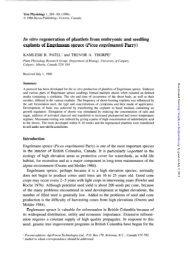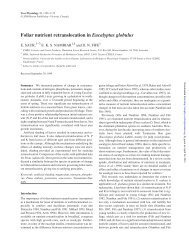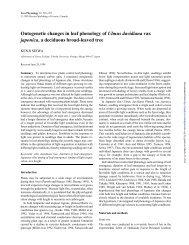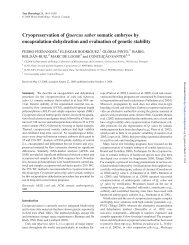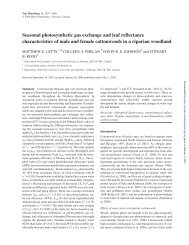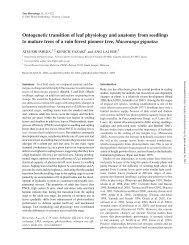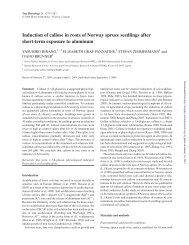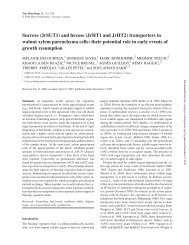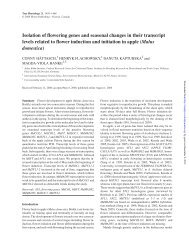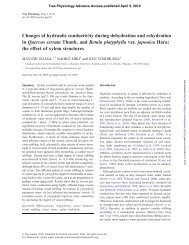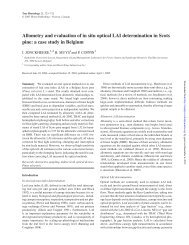Factors influencing axillary shoot proliferation and ... - Tree Physiology
Factors influencing axillary shoot proliferation and ... - Tree Physiology
Factors influencing axillary shoot proliferation and ... - Tree Physiology
You also want an ePaper? Increase the reach of your titles
YUMPU automatically turns print PDFs into web optimized ePapers that Google loves.
C. libani, respectively), none of the cultured explants differentiated<br />
adventitious buds.<br />
In subsequent experiments, mature C. atlantica embryos<br />
were cultured on MSBN/2 medium with or without Z <strong>and</strong> BA.<br />
Within the first week of culture, embryos elongated <strong>and</strong> the<br />
cotyledons <strong>and</strong> hypocotyls became green. Embryos on basal<br />
medium produced no callus or adventitious buds, developing<br />
as normal seedlings. In the presence of cytokinins, hypocotyls<br />
<strong>and</strong> cotyledons in contact with the medium proliferated quickly,<br />
producing callus. Usually the radicles did not show a response<br />
either in color or in cell <strong>proliferation</strong>. The first adventitious<br />
buds were directly induced from the upper surface of the<br />
hypocotyls (Figure 2A) after 20–30 days of culture. Further<br />
bud differentiation occurred on the surface of the previously<br />
induced calli. Indirect needle primordia differentiation was<br />
also observed, especially when embryos were cultured in the<br />
presence of BA. After 50–60 days, the entire upper surface of<br />
the responding embryos was covered with adventitious buds<br />
<strong>and</strong> needles, although the latter did not develop into <strong>shoot</strong>s.<br />
Table 5 summarizes the bud differentiation process in cultured<br />
C. atlantica embryos. The bud-forming capacity of the<br />
explants depended on cytokinin type <strong>and</strong> concentration, the<br />
best results being obtained when the embryos were cultured in<br />
the presence of 9 µM Z (47% of caulogenic explants <strong>and</strong><br />
4.2 adventitious buds per embryo), whereas 9 µM BA induced<br />
a smaller response (13% <strong>and</strong> 0.3, respectively). Embryo subculture<br />
to medium with 4.4 mM Z enhanced the development<br />
of adventitious buds (Figure 2B). Further <strong>shoot</strong> elongation was<br />
achieved following excision <strong>and</strong> transfer of these <strong>shoot</strong>s to<br />
hormone-free medium. Transfer of embryos bearing adventitious<br />
buds to basal medium did not promote bud elongation<br />
(data not shown).<br />
Although WPM provided a greater percentage of embryos<br />
with buds than MSBN/2 medium (49.0 versus 40.0%, P =<br />
0.05), the mean number of buds formed per embryo in the<br />
presence of 9 µM Z was similar in the two media (3.1). Irrespective<br />
of the nutrient medium, 18 µM Z enhanced acicular<br />
primordia differentiation <strong>and</strong> reduced adventitious bud differentiation.<br />
Rooting<br />
Rooting experiments were carried out with <strong>axillary</strong> <strong>and</strong> adventitious<br />
<strong>shoot</strong>s isolated from proliferating cedar cultures of ju-<br />
SHOOT PROLIFERATION IN CEDAR CULTURES 483<br />
TREE PHYSIOLOGY ONLINE at http://heronpublishing.com<br />
Table 5. Effects of cytokinin type <strong>and</strong> concentration on the differentiation<br />
of adventitious buds from embryos of C. atlantica. Values are<br />
combined means of results from two experiments of 20 observations<br />
each. Cultures were established on MSBN/2 medium <strong>and</strong> culture time<br />
was 60 days. Within a column, values followed by different letters are<br />
significantly different according to Tukey’s test at P ≤ 0.05.<br />
Cytokinin Concentration Explants with Buds per<br />
(µM) buds (%) explant<br />
Z 0.0 0.0 0.0<br />
2.2 13.3 0.8<br />
4.4 33.3 1.3<br />
6.6 33.3 0.8<br />
9.0 46.7 4.2<br />
Mean 25.3 a 1.4 a<br />
BA 0.0 0.0 0.0<br />
2.2 6.7 0.1<br />
4.4 6.7 0.1<br />
6.6 13.3 0.1<br />
9.0 13.3 0.3<br />
Mean 8.0 b 0.1 b<br />
venile <strong>and</strong> adult origin. None of the experimental variables<br />
tested promoted rooting.<br />
Discussion<br />
We observed in vitro <strong>axillary</strong> bud <strong>proliferation</strong> of explants<br />
from juvenile <strong>and</strong> adult C. atlantica <strong>and</strong> C. libani trees. In both<br />
species, explant size was an important factor affecting <strong>axillary</strong><br />
bud <strong>proliferation</strong> in in vitro culture. Piola <strong>and</strong> Rohr (1996) reported<br />
that <strong>axillary</strong> <strong>and</strong> apical buds from in-vitro-grown microcuttings<br />
of C. libani sprout at 30 °C but not at 24 °C. Subsequently,<br />
Piola et al. (1998) demonstrated that needle removal,<br />
but not microcutting decapitation, substituted for the higher<br />
temperature requirement to break bud dormancy. Abscisic<br />
acid (ABA) concentrations in microcuttings with dormant<br />
buds were higher than in microcuttings bearing sprouted buds,<br />
leading these authors to suggest that ABA accumulation in<br />
needles caused bud dormancy of C. libani microcuttings at<br />
24 °C. Therefore, we always used defoliated microcuttings, to<br />
Figure 2. Induction <strong>and</strong> development<br />
of adventitious buds from cultured embryos<br />
of C. atlantica. Adventitious bud<br />
differentiation on MSBN/2 medium<br />
with 9 µM Z (left) <strong>and</strong> adventitious<br />
bud development on MSBN/2 medium<br />
with 4.4 µM Z (right). Bar = 0.3 cm.<br />
Downloaded from<br />
http://treephys.oxfordjournals.org/ by guest on June 5, 2013



